System Simulation
in Buildings 2014
December 10 – 12, 2014
Organised by :
The Thermodynamics Laboratory
Aerospace & Mechanics Department
University of Liège
Campus du Sart-Tilman
Bâtiment B49 – Parking P33
B-4000 Liège, Belgium
2015
Proceedings of the Ninth
International Conference
System Simulation in Buildings 2014
Proceedings of the Ninth International Conference
Thermodynamics Laboratory Aerospace & Mechanics Department University of Liège
Atelier des Presses
Atelier des Presses
Atelier des Presses
Atelier des Presses
Atelier des Presses
Chemin des Amphithéâtres - Bât B7a 4000 Liège (Belgique)
© 2015
Tous droits de reproduction, d’adaptation et de traduction réservés pour tous pays.
Ouvrage mis en page par l’auteur Imprimé en Belgique
D/2015/13.315/5
ISBN : 978-2-930772-10-3
Atelier des Presses
Atelier des Presses
System Simulation
in Buildings 2014
Proceedings of the Ninth
International Conference
The Thermodynamics Laboratory
of the University of Liège
Atelier des Presses
Atelier des Presses
S
YSTEM
S
IMULATION
IN
B
UILDINGS
2014
Proceedings of the Ninth
International Conference
Organized by:
The Thermodynamics Laboratory
Aerospace & Mechanics Department
University of Liège
Campus du Sart-Tilman
Bâtiment B49 – Parking P33
December 10-12, 2014
Proceedings of the Ninth International Conference SSB2014 iii Vincent Lemort Conference Chairman Thermodynamics Laboratory Université of Liege vincent.lemort@ulg.ac.be Philippe André
Scientific Committee Chairman BEMS - Arlon Université of Liege p.andre@ulg.ac.be Francois Randaxhe Conference Secretary Thermodynamics Laboratory Université of Liege F.Randaxhe@ulg.ac.be
Scientific Committee
BERTAGNOLIO Stephane BRAUN James CORGNATI StefanoCUEVAS BARRAZA Cristian
DEWALLEF Pierre FISSORE Adelqui HEISELBERG Per HELSEN Lieve JIANJUN Xia KUMMERT Michael LEBRUN Jean MADJIDI Madjid MASY Gabrielle RASLAN Rokia SAELENS Dirk STABAT Pascal THOMAS Sébastien VERHELST Clara WOLFRAM Stephan XIAOHUA Liu
Emerson Climate Technologies GmbH, Germany
Purdue University, U.S.A.
Politecnico di Torino, Italy
Universidad de Concepcion, Chile
University of Liege - Thermodynamics Laboratory, Belgium
Universidad de Concepcion, Chile
AAU - Aalborg University, Denmark
Leuven University (KUL), Belgium
Tsinghua University, P.R. China
Ecole Polytechnique de Montréal, Canada
University of Liege / JCJ Energetics / ATIC
Ingenieurbüro Madjidi
HEPL – CECOTEPE
The Bartlett School of Graduate Studies – UCL
Leuven University (KUL), Belgium
Ecole des Mines – ParisTech, Belgium
SECOLUX, Luxembourg
3E, Belgium
Technische Hochschule Nürnberg Georg Simon Ohm
Proceedings of the Ninth International Conference SSB2014 iv
F
OREWORDL
IST OFP
ARTICIPANTSF
IRSTS
ESSION–
A
DVANCED CONTROL OF SYSTEMS IN BUILDINGS•
P01: A convex approach to energy use minimization of buildings equipped
with hybrid ground-coupled heat pumps
Ercan Atam, Damien Picard, Lieve Helsen – Department of Mechanical
Engineering, KU Leuven (Belgium)
•
P02: Comparisons of model structure and identification methods for
multiple-RTU coordination
Donghun Kim, Jie Cai, James E. Braun – Ray W. Herrick Laboratories,
School of Mechanical Engineering, Purdue University, (USA)
•
P03: Extraction of heating control rules from the dynamic programming
method for load shifting in energy-efficient buildings
Maxime Robillart, Patrick Schalbart and Bruno Peuportier– MINES
ParisTech, PSL - Research University, CES - Centre for energy efficiency
of systems (France)
•
P04: Assessing simplified and detailed models for predictive control of
space heating in homes
Kun Zhang, Narges Roofigari E., Humberto Quintana, Michaël Kummert–
Polytechnique Montréal, Montréal (Canada)
S
ECONDS
ESSION– I
NTEGRATION OF RENEWABLE ENERGY SOURCES IN BUILDINGS•
P05: Impact of storage tank control and hydraulic configuration on solar
heat pump system performance
John Veeken, Jan Verheyen and Maarten Sourbron – KU Leuven (University
of Leuven), Department of Mechanical Engineering, Technology Campus
De Nayer, Sint-Katelijne-Waver (Belgium)
Proceedings of the Ninth International Conference SSB2014 v
Olivier Dumont
, Carolina Carmo
, François Randaxhe
, Sylvain Quoilin
,
Vincent Lemort
1–
(1)Thermodynamics laboratory, University of Liege,
Liege (Belgium),
(2)Department of Energy Technology, Aalborg University,
Aalborg (Denmark)
•
P07: Integration and Evaluation of Innovative and Renewable Energy
Technologies in a Canadian Mid-rise
Martin Kegel, Justin Tamasauskas and Roberto Sunye– Natural Resources
Canada, Varennes (Canada)
•
P08: A computational model for optimizing district heating systems using
a slow responsive renewable heat source and thermal storage
F.F.M. Soons
1,2, J. Ignacio Torrens
1, J.L.M. Hensen
1, R.A.M. De Schrevel
2–
(1)Dep. Building Physics and Services, Eindhoven University of
Technology, (Netherlands),
(2)Dep. Business Development Energy, Cofely
Netherlands NV., Maastricht (Netherlands)
T
HIRDS
ESSION– S
IMULATION ASSISTED ANALYSIS AND EVALUATION OF BUILDING ENERGY USE•
P09: Office building HVAC system analysis through integrated dynamic
simulation
Wout Parys, Hugo Hens and Dirk Saelens – Building Physics Section, KU
Leuven, Leuven (Belgium)
•
P10: The influence of realistic schedules for the use of appliances on the
total energy performances in dwellings
Tiziana Buso, Simona D’Oca, Stefano Paolo Corgnati – TEBE Research
Group, Energy Department, Politecnico di Torino, Corso Duca degli
Abruzzi 24, 10129, Torino (Italy)
•
P11: The Energy Performance Certification: A tool for smarter cities?
Stephane Monfils,
Jean-Marie Hauglustaine – University of Liege (Belgium)
•
P12: The Mapping of Climate-Dependent Simplified Thermal Systems
using State Space Models
A.W.M. (Jos) van Schijndel – Eindhoven University of Technology,
(Netherlands)
Proceedings of the Ninth International Conference SSB2014 vi
•
P13: Application of users’ light-switch stochastic models to dynamic
energy simulation
V. Camisassi, V. Fabi, RK. Andersen, SP. Corgnati –
(1)TEBE Research
Group, Department of Energetics, Politecnico di Torino, Corso Duca degli
Abruzzi 24, 10129 Torino (Italy),
(2)ICIEE, Department of Civil
Engineering, Technical University of Denmark, Nils Koppels Allé Building
402, 2800 Kgs. Lyngby (Denmark)
•
P14: Low order model selection for optimised heating start-up in tertiary
buildings: Review and comparison of different approaches through a case
study
Joachim Verhelst
1, Dirk Saelens
2, Geert Van Ham
1and Lieve Helsen
3–
(1)
Knowledge Centre for Energy, KU Leuven Faculty of Engineering
Technology, Geel (Belgium),
(2)Building Physics Section, KU Leuven,
Leuven (Belgium),
(3)Mechanical Engineering Department, KU Leuven,
Leuven (Belgium)
•
P15: Design and Optimization of Geothermal Heat Pumps in Combination
with TABS
Arno Dentel
1, Thomas Dippel
2, Mario Franz
1, Wolfram Stephan
1–
(1)
Technische Hochschule Nürnberg Georg Simon Ohm, Institute for Energy
and Buildings, Energie Campus Nürnberg, Keßlerplatz 12, 90489 Nürnberg
(Germany),
(2)TEB – Transferzentrum Energieeffizientes Bauen GmbH
Kehlstraße 27/1, 71665 Vaihingen an der Enz, (Germany)
•
P16: Modelling the impact of integrated electric vehicle charging and
domestic heating strategies on future energy demands
John Hand, Nick Kelly, Aizaz Samuel – Energy Systems Research Unit
(ESRU), Department of Mechanical and Aerospace Engineering, University
of Strathclyde Glasgow (Scotland)
F
IFTHS
ESSION– E
XPERIMENTAL STUDIES•
P17: ISABELE method: In-Situ Assessment of the Building EnveLope
pErformances
Pierre Boisson and Rémi Bouchié – Université Paris Est - Centre
Scientifique et Technique du Bâtiment, Marne-la-Vallée (FRANCE)
Proceedings of the Ninth International Conference SSB2014 vii
by Wood Stoves
Laurent Georges
1, Øyvind Skreiberg
2–
(1)Department of Energy and Process
Engineering, Norwegian University of Science and Technology (NTNU),
Trondheim (Norway),
(2)Department of Thermal Energy, SINTEF Energy
Research, Trondheim (Norway)
•
P19: A TRNSYS-LabVIEW bi-directional connection for HVAC
equipment testing using hardware-in-the-loop simulation
Francesca Macdonald
1, Katherine D’Avignon
1, Michaël Kummert
1, and
Ah-med Daoud
2–
(1)Polytechnique Montréal, Mechanical Engineering,
Montréal (Canada),
(2)Institut de Recherche d'Hydro-Québec, Shawinigan,
Canada
•
P20: Experimental study on a new energy-efficient VRF system
Xiaochen Mao, Jianjun Xia – Building Energy Research Centre, Tsinghua
University, Beijing (China)
S
IXTHS
ESSION– B
UILDING MODEL VALIDATION•
P21: Calibrating whole house thermal models against a coheating test
standard: solid wall case studies
James Parker, David Farmer, Martin Fletcher – Leeds Beckett University,
Leeds, (UK)
•
P22: An adapted co-heating test and experimental infrastructure for
thermal dynamic response and performance identification of residential
building
Guillaume Lethé, Paul Steskens, Gilles Flamant, Brieuc Meurisse – Belgian
Building Research Institute, Brussels (Belgium)
•
P23: Full scale empirical validation for building energy simulation
programs
Matthias Kersken
1, Ingo Heusler
1and Paul Strachan
2–
(1)Fraunhofer
Institute for Building Physics IBP, Holzkirchen (Germany),
(2)University of
Strathclyde, ESRU, Dept. of Mechanical and Aerospace Eng. (UK)
•
P24: Back from Holzkirchen full scale dynamic testing experiment
Gabrielle Masy
1, Florent Delarbre
1, Jean Lebrun
2, Emeline Georges
3,
Proceedings of the Ninth International Conference SSB2014 viii
of Liège (Belgium)
S
EVENTHS
ESSION– I
NTEGRATION OF BUILDINGS IN SMART ENERGY GRIDS•
P25: Impact of net metering programs on optimal load management in US
residential housing – a case study
Emeline Georges
1, Jim Braun
2, Eckhard Groll
2, Travis Horton
2and Vincent
Lemort
1–
(1)Thermodynamics Laboratory, University of Liège, Liège
(Belgium),
(2)Ray W. Herrick Laboratories, Purdue University,
West-Lafayette, Indiana (USA)
•
P26: GIS supported city district energy system modeling
Jan Schiefelbein
1, Amir Javadi
1, Michael Diekerhof
1, Dirk Müller
1,
Antonello Monti
2– RWTH Aachen University, E.ON Energy Research
Center,
(1)Institute for Energy Efficient Buildings and Indoor Climate
(2)
Institute for Automation of Complex Power Systems, Aachen (Germany)
•
P27: Strategies for an Optimal Chiller Operation (in a Smart Grid)
Julian Buderus, Arno Dentel, Wolfram Stephan – Technische Hochschule
Nürnberg Georg Simon, Institute for Energy and Building, Nuremberg,
(Germany)
•
P28: Residential buildings with heat pumps, a verified bottom-up model
for demand side management studies
Dieter Patteeuw, Lieve Helsen – Applied Mechanics and Energy
Conversion, Department of Mechanical Engineering, KU Leuven (Belgium)
E
IGHTHS
ESSION– A
DVANCES IN COMPONENT MODELING•
P29: Finite cylinder-source model for pile/borehole heat exchangers:
effects of temperature response to time varying thermal load
Tatyana V. Bandos
1,3, Álvaro Campos-Celador
2, Luis M. López González
3,
José M. Sala Lizárraga
1,2–
(1)Dpto. de Máquinas y Motores Térmicos,
University of the Basque Country UPV/EHU, Bilbao (Spain),
(2)Grupo de
Investigación ENEDI, Dpto. de Máquinas y Motores Térmicos, University
of the Basque Country UPV/EHU (Spain),
(3)Grupo de Investigación
Proceedings of the Ninth International Conference SSB2014 ix
John D. Bynum
and David E. Claridge
–
Eindhoven University of
Technology, Eindhoven (The Netherlands),
(2)Texas A&M University &
Energy Systems Laboratory, College Station, TX (USA)
•
P31: Numerical analysis on the performance of two-stage desiccant wheel
system
Yuwei Zheng
1, Xiaohua Liu
1, Rang Tu
2–
(1)Department of Building Science,
Tsinghua University, Beijing (China),
(2)School of mechanical engineering,
University of Science and Technology Beijing, Beijing (China)
•
P32: Model development and experimental parameter identification for
biomass pellet boilers in buildings
Jens Petzold, Daniel Büchner, Andreas Ortwein – Deutsches
Biomasse-forschungszentrum gemeinnützige GmbH (Germany)
N
INTHS
ESSION– M
ODEL REDUCTION•
P33: Bottom-up modeling of the Belgian residential building stock:
influence of model complexity
Glenn Reynders
1,2,3, Jan Diriken
1,3, Dirk Saelens
1,2–
(1)Energyville
(Belgium),
(2)Building Physics Section, Civil Engineering Department, KU
Leuven (Belgium),
(3)Unit Energy Technology, VITO (Belgium)
•
P34: ISABELE: a Method for Performance Assessment at Acceptance
Stage using Bayesian Calibration
Pascal Schetelat and Remi Bouchie – Centre Scientifique et Technique du
Bâtiment (France)
•
P35: A practical and scalable inverse modeling approach for multi-zone
buildings
Jie Cai and James E. Braun – Ray W. Herrick Laboratory, Purdue University
(USA)
•
P36: Comparative analysis of model reduction methods applied to building
simulation benchmarks
Jordan Gauvrit, Guillaume Ansanay-Alex – Centre Scientifique et
Technique du Bâtiment (France)
Proceedings of the Ninth International Conference SSB2014 x
•
P37: Bottom-up modelling of the Belgian residential building stock:
impact of building stock descriptions
Christina Protopapadaki
1,2, Glenn Reynders
1,2,3and Dirk Saelens
1,2–
(1)
Building Physics section, KU Leuven (Belgium),
(2)Energyville (Belgium)
•
P38: Dynamic exergy simulation coupled with thermoeconomic analysis
to support retrofit decisions in non-domestic buildings
Ivan Garcia Kerdan
1, Rokia Raslan
2and Paul Ruyssevelt
1–
(1)Energy
Institute, University College London, (UK),
(2)Institute for Environmental
Design and Engineering, University College London, (UK)
•
P39: The Potential of Air-Water Heat Pumps in a Belgian Residential
Retrofit Context in relation to Future Electricity Prices
Evelyn Heylen
1, Romain Jordens
1, Dieter Patteeuw
2, Lieve Helsen
2–
(1)
Master Energy KU Leuven, Leuven (Belgium),
(2)Department of
Mechanical Engineering, Division of Applied Mechanics and Energy
Conversion (TME), Leuven, (Belgium)
Proceedings of the Ninth International Conference SSB2014 xi This 9th International Conference on System Simulation in Buildings has been the opportunity to gather researchers coming from 13 countries, sharing the last results of their research works. Some of the presented works were conducted in the frame of projects from the International Energy Agency’s Energy in Buildings and Communities Programme (EBC).
In the name of the organizing committee, I would like to thank:
- The authors who wrote highly interesting papers reviewed afterwards by their peers. - The members of the Scientific Committee who conducted an excellent reviewing of the
papers, and contributed to maintain the high quality of the conference.
- The participants for the interesting and fruitful discussions they initiated during and after the presentations.
- The research and administrative team of the Thermodynamics Laboratory, and particularly François Randaxhe and Isabelle Cosyns, who made this event possible and successful.
I hope that the diffusion of the present proceedings will contribute, even to a small extent, to improving the energy performance of buildings by promoting the development of simulation tools and by sharing these tools among scientist and engineering offices.
I wish you a pleasant reading.
Vincent Lemort
Chairman of SSB 2014
Proceedings of the Ninth International Conference SSB2014 xii
Aertgeerts Arnout KU Leuven BEL
André Philippe Université de Liège BEL
Ansanay Guillaume CSTB FRA
Aparecida S. Cleide JCJ Energetics BEL
Atam Ercan KU Leuven BEL
Attia Shady Université de Liège BEL
Bandos Tatyana Universidad del Pais Vasco ESP
Bertagnolio Stephane Emerson Climate Technologies GmbH BEL
Boisson Pierre CSTB FRA
Bouche Rémi CSTB FRA
Boydens Wim Studiebureau r. boydens nv BEL
Buderus Julian T.H. Nürnberg Georg Simon Ohm DEU
Buso Tiziana Politecnico di Torino ITA
Braun Jim Purdue University USA
D. Bynum John Eindhoven University of Technology NED
Camisassi Vittoria Politecnico di Torino ITA
Carmo Carolina Aalborg university DNK
Carton Julien ICSEED FRA
Corgnati Stefano Politecnico di Torino ITA
Cuevas Cristian Universidad de Concepción CHL
Daoud Ahmed Hydro-Québec (LTE) CAN
Dechesne Bertrand Université de Liège (Labothap) BEL
Dewallef Pierre Université de Liège BEL
Dentel Arno T.H. Nürnberg Georg Simon Ohm DEU
Dippel Thomas TEB GmbH DEU
Dumont Olivier Université de Liège (Labothap) BEL
Garcia Kerdan Ivan Energy Institute, University College London GBR
Gendebien Samuel Université de Liège (Labothap) BEL
Georges Bernard Université de Liège (Labothap) BEL
Georges Emeline Université de Liège (Labothap) BEL
Georges Laurent Norwegian University of Science and Technology NOR
Proceedings of the Ninth International Conference SSB2014 xiii
Heylen Evelyn KU Leuven BEL
Jianjun Xia Tsinghua University CHN
Johra Hicham Aalborg university DNK
Jorissen Filip KU Leuven BEL
Kegel Martin Canmet ENERGY/Natural Resources Canada CAN
Kelly Nick University of Strathclyde GBR
Kersken Matthias Fraunhofer Institute for Building Physics IBP DEU
Lebrun Jean JCJ Energetics BEL
Lemort Vincent Université de Liège (Labothap) BEL
Lethe Guillaume CSTC – WTCB – BBRI BEL
Madjidi Madjid Ingenieurbüro Madjidi DEU
Masy Gabrielle Haute Ecole de la Province de Liège BEL
Monfils Stephane University of Liege BEL
Patteeuw Dieter KU Leuven BEL
Parker James Leeds Metropolitan University GBR
Parys Wout Building Physics Section, KU Leuven FRA
Petzold Jens DBFZ gGmbH DEU
Protopapadaki Christina KU Leuven BEL
Randaxhe Francois Université de Liège (Labothap) BEL
Ransy Frederic Université de Liège (Labothap) BEL
Raslan Rokia The Bartlett School of Graduate Studies – UCL GBR
Reynders Glenn Building Physics Section, KU Leuven BEL
Robillart Maxime MINES ParisTech FRA
Ruiz Roberto Université de Liège (Labothap) BEL
Saelens Dirk Katholieke Universiteit Leuven BEL
Schetelat Pascal CSTB FRA
Schiefelbein Jan RWTH Aachen University, E.ON Energy DEU
Heylen Evelyn KU Leuven BEL
Soons Frank Eindhoven University of Technology NED
Sourbron Maarten Campus De Nayer, KU Leuven BEL
Stabat Pascal Ecole de Mines - ParisTech FRA
Proceedings of the Ninth International Conference SSB2014 xiv
Van der Heijde Bram KU Leuven BEL
Van Schijndel Jos Eindhoven University of Technology NED
Veeken John Campus De Nayer, KU Leuven BEL
Verhelst Joachim KULeuven BEL
Verhelst Clara 3E BEL
Wolfram Stephan T.H. Nürnberg Georg Simon Ohm DEU
Xiaochen Mao Tsinghua University CHN
Zhang Kun École Polytechnique de Montréal CAN
Zheng Yuwei Tsinghua University CHN
F
IRST
S
ESSION
A
DVANCED
C
ONTROL OF
9th International Conference on System Simulation in Buildings, Liege, December 10-12, 2014
A Convex Approach to Energy Use Minimization of Buildings
Equipped with Hybrid Ground-Coupled Heat Pump Systems
Ercan Atam, Damien Picard, Lieve Helsen
Department of Mechanical Engineering, KU Leuven, Celestijnelaan 300A, Leuven 3001, Belgium.
1. ABSTRACT
In this paper a convex approach through convexification is presented for non- convex optimal control and non-convex model predictive control based energy use minimization of buildings equipped with the hybrid ground-coupled heat pump systems. The original non-convex problems are convexified using a convex envelope approach. The results of convexified optimal control problem are com- pared with dynamic programming based optimal control, which is a global and closed-loop control approach. The comparison results show that the convex approximation of the optimal control problem gives almost global optimal results in terms of responses and cost criteria. The suggested method is especially useful for optimal/model predictive control or optimal design of energy-efficient buildings integrated with thermal systems, where the source and sink temperature dependent coefficient of performance of some thermal components introduces non-convexity into the system.
Keywords: Hybrid ground-coupled heat pumps, Convex optimization, Convex envelope, Optimal control, Nonlinear model predictive control.
2. NOMENCLATURE
Variables Description
COPch chiller coefficient of performance
COPhp heat pump coefficient of performance
COPpc passive cooler coefficient of performance
ce electricity price cg gas price J total cost tc control horizon tp prediction horizon ts sampling period
power used by chiller
power used by gas boiler power
power used by heat pump
power used by passive cooler
cooling load demand
thermal energy extracted from the building through active cooling
heat extracted from ground
thermal energy supplied to the building by gas boiler
heating load demand
9th International Conference on System Simulation in Buildings, Liege, December 10-12, 2014
heat injected to ground
net heat injected to ground
thermal energy extracted from the building through passive cooling
Ta ambient air temperature
Tf fluid mean temperature
ηgb gas boiler efficiency
3. INTRODUCTION
In last decades, ground-coupled heat pumps (GCHP) and hybrid ground-coupled heat pumps (HybGCHP) combined with low-exergy heat emission systems received considerable attention (Chiasson, 2007)(Hackel et al., 2011)(Atam et al., 2013). This attention comes from having the potential to reduce the primary energy use related to space heating and cooling by 70% compared to conventional heating and cooling systems (DHC, 2014).For GCHP systems with vertical borehole heat exchangers (BHE), however, the large investment cost of the borefield represents a major bottleneck. This explains the trend towards compact, hybrid GCHP systems which combine smaller boreholes with supplementary heating or cooling devices such as gas-fired boilers and chillers. Although the design of a compact HybGCHP system is often driven by cost considerations to limit the drilling cost without compromising thermal comfort in the building, sometimes other reasons may also lead to HybGCHP systems, such as limited drilling area for boreholes, the specific ground characteristics, regulation or too high imbalance of the thermal load. Under normal conditions, the efficiency of the additional heating or cooling devices being lower, a long-term cost-optimal operation boils down to maximizing the use of the heat pump and passive cooling in covering the heating and cooling loads within certain temperature constraints for the heat carrier fluid. Although we have this kind of a qualitative nature of optimal control policy in our mind, determination of quantitative values of optimal load sharing between components requires an intelligent control strategy when multiple operational constraints such as maximum machine power and temperature bounds of the heat carrier fluid have to be taken into account.
A rule-based controller that uses the most efficient machine at each time step might be the simplest algorithm to use. This kind of controller is, however, not able to make full use of the temperature constraints of the heat carrier fluid. For example Cullin et al. (2010), proposed rule-based control strategies coupled with a set of parameters to optimize the system performance using a simulation based optimization method. Multiple simulations with different initial-boundary conditions and heating-cooling demand scenarios have been considered and the optimization parameters are optimized either manually or through a simulation-coupled optimization program such as GenOpt (Wetter, 2001) until satisfactory performance was observed in the simulations. The main drawbacks of these approaches are that firstly, they suffer from a mathematical model-based optimization/control and hence the suggested rule-based control methods may be very suboptimal strategies in general and secondly, the number of variables to be optimized in a rule-based control is restricted most of the time since few parameters are chosen to characterize the optimal control performance.
Ridder et al. (2011) and Verhelst (2012) used, in contrast to rule-based approaches, mathematical model-based control methods, which allow global optimization. However, they are based on some simplifications and/or some unrealistic assumptions introduced during the controller design. For example, Ridder et al. (2011) used dynamic programming. Dynamic programming is a powerful method since it is a closed-loop, global optimal control algorithm. However, the model used in Ridder et al. (2011) for dynamic programming is a very simple
9th International Conference on System Simulation in Buildings, Liege, December 10-12, 2014
first-order model for the ground mean temperature. The chosen sampling period for the system is one week, which is very long since typical control actions for buildings may require sampling times in order of minutes or hours. More- over, the realization of the designed controller requires the measurement of the underground field temperature, for which measurement may be either difficult or non-accurate. As a result, the approach of Ridder et al. (2011) involves both some modeling simplifications and a hard-to-realize implementation. As to Verhelst (2012), a linear optimal control method is applied. The simplification made in that work is that the coefficients of performance (COP) for heat pump and chiller were taken to be constant, in contrast to being functions of source and sink temperatures. COP values were taken to be constant because otherwise the optimization problem is a nonlinear, non-convex problem, which cannot be solved over a couple of years especially when short sampling times are considered. Although a mathematical model-based optimal control was considered, the simplifications of taking the mentioned COPs as constant values without a formal justification restricts the validity of the work of Verhelst (2012). Moreover, the model used for control and emulator are the same, which eliminates the impact of model mismatch and therefore limits the generality of the approach followed by Verhelst (2012).
The optimal control of HybGCHP systems for total energy use minimization is a nonlinear, non-convex optimization problem due to the appearance of heat pump coefficient of performance in the cost function. This makes the optimization problem difficult for short sampling periods in the order of minutes or hours because short sampling periods increase the number of decision variables considerably. Current solvers have difficulty in solving a non-convex, nonlinear optimization problem with a large number of decision variables. Even in case of a solution, a global minimum cannot be guaranteed. An approximate solution to the above problem is the convex relaxation of the nonlinear, non-convex optimization problem through the use of a convex envelope approach. The convex envelope of a function is the largest convex function majorized by that function. Approximation of the non-convex terms by their convex envelopes will transform the optimization problem to an approximate problem which is convex and for which the global minimum can be found, if the problem is feasible. In convex optimization problems, a local minimum is a global minimum. Although the calculation of a convex envelope for a general multi-variable function is non-deterministic polynomial-time hard, there exist analytical formulas for a bilinear function or a rational function of two variables, the type of functions encountered in energy use minimization of HybGCHP systems. In this paper, the use of a convex relaxation method is given for non-convex optimal control and non-convex model predictive control of HybGCHP systems, by replacing the non-convex term with its convex envelope. The results of optimal control case are compared with dynamic programming control results (an approximate global optimal control algorithm) to assess the optimality of the convex envelope approach. The proposed approach gives promising results for optimal control of HybGCHP systems. The utilization of convex envelope approach for nonlinear, non-convex model predictive control formulation is also illustrated. Since model predictive control does not see the whole control period over which the system is controlled, it was not perfectly meaningful to compare with dynamic programming which sees the whole control period. The rest of paper is structured as follows. In Section 2, the HybGCHP sys- tem is described with the associated operational constraints. Section 3 deals with the formulation of the non-convex optimal control problem for the total energy use minimization for HybGCHP systems. The convexification of the optimization problem starting from basic elements of convex optimization and the convex envelope concept is given in Section 4. The dynamic programming-based control formulation and solution of the problem is given in Section 5 where dynamic programming is used as the base reference for comparing the results. Section 6
9th International Conference on System Simulation in Buildings, Liege, December 10-12, 2014
discusses the applicability of the proposed method in the context of nonlinear, non-convex model predictive control. Finally, Section 7, concludes with the main findings of this study. 4. GCHP SYSTEM DESCRIPTION & OPERATIONAL CONSTRAINTS
The hybrid system is presented in Figure 1 and consists of a heat pump, a gas-fired boiler, a passive cooler and an air-cooled chiller. It is assumed that the heat demand ( ) is provided by heat pump and boiler and the cold demand ( ) is provided by passive cooler (using a heat exchanger instead of an active chiller) and chiller. The expressions for the efficiencies (η) and coefficient of performance (COP) of all components presented in Figure 1 are given by
= , = , = , = ,
where denotes the electricity consumption of the heat pump compressor and the power consumed by circulation pumps from the borefield side, denotes the rate of primary energy use of the gas boiler, the electricity power used for the circulation pumps of the passive cooling installation and finally denotes the electricity power consumption of the chiller compressor and the circulation pumps of the cooling tower.
Figure 1: Schematic presentation of hybrid system: heat pump, gas-fired boiler, passive cooler and chiller.
The coefficients of performance given by the above expressions depend on the temperatures of the source and the emission system, as expressed by
= , , , = , , , = , , ,
where , , , represent the water supply temperature for heating and water supply temperature for cooling, respectively. is the ambient temperature and is the circulating fluid mean temperature. The gas boiler efficiency, , is given a constant value of unity. The electricity price ( ) varies in the range [0.09, 0.15] euro/(kWh) and ( ) is taken 0.06 euro/(kWh) (Verhelst, 2012). Here, COPs and efficiencies are fitted to TRNSYS data (TRNSYS, 1998):
( ) = "#+ "% ( ), ( ) = &#+ &% ( ) + &' ²( ), = 12 (1)
where and are fitted for a supply water temperature of , = 40°C for heating and a supply water temperature of , = 18°C for cooling. Using ( ) and ( ), the optimal
9th International Conference on System Simulation in Buildings, Liege, December 10-12, 2014
control problem to be solved to minimize the energy use cost function for HybGCHP system operation over a time period [ #, ] is
+ ≅ - . (/) 0 (/)(/) + (/)(/) + (/)(/)1 + (/) (/)2
34%
56#
(2)
where ts is the sampling period and “k” is the sampling instant. The cost function presented by Eq. (2) has to be minimized under operational temperature constraints, heat/cold demands, maximum net heat injected in the ground and power constraints. Next, we will discuss these constraints and present their expressions.
4.1
Heat & cold demand satisfaction and circulating fluid temperature bounds
The building loads should be satisfied with some acceptable violation margins:
( ) − 8 49( ) ≤ ( ) + ( ) ≤ ( ) + 8 4;( ) (3a)
( ) − 8 49( ) ≤ ( ) + ( ) ≤ ( ) + 8 4;( ) (3a)
where ( ) and ( ) are the building heat and cold demands, respectively, 8 49( ), 8 4;( ) are time-dependent lower and upper violation margins for heating demand and 8 49( ), 8 4;( ) the lower and upper violation margins for cooling demand. Note that and are assumed to be given. The cooling of a building requires heat injection to ground during summer. This increases the ground temperature towards winter, which, in turn, increases COPhp. However, the ground temperature, which is represented indirectly by , should be kept below the water supply temperature, , , for passive cooling of the building. Similarly, heating of a building requires heat extraction from the ground. This decreases the ground temperature towards summer, which, in turn, increases COPpc. However, again the ground temperature represented indirectly by should not decrease to a value below freezing point to avoid frost problems. All these aspects require to put lower and upper bounds on :
4< ( ) < ( ) < 4< ( ) (4)
4.2
Heat exchange with ground
Heat extraction/injection from/to the ground and the net heat transfer with the ground are given by the following equations
( ) = ( ) − 1( ) ( ), ( ) = ( ) − 1( ) ( ),
( ) = ( ) − ( ).
(5)
To limit the degree of thermal build up or depletion in the ground, the following bound may be put on the net annual heat transfer with the ground
>
-%? @
> < < . (6)
4.3
Borehole Dynamics
In this section the borefield system shown in Figure 1 is modeled as a single equivalent borehole which is sized according to the specified building loads to be considered in the next sections.
9th International Conference on System Simulation in Buildings, Liege, December 10-12, 2014
This is an approximation neglecting the interaction between different boreholes in a borefield. In the equivalent diameter approach, the heat transfer from the U-tube is approximated by the heat transfer from a single pipe with a hypothetical diameter through which the heat exchanging fluid circulates. The objective is the determination of the circulating fluid mean temperature over the borehole length, ( ), corresponding to a net (injected - extracted) heat profile per unit length, B . The one-dimensional radial conduction heat transfer equation is considered. Next, the grout and ground regions are divided into thermal nodes and an energy balance for the equivalent borehole is considered. Using the finite volume technique, the following large-scale dynamic model is obtained
C (/ + 1) = D (E)C (/) + F (E)B (/), G(/) = (/) = C (/) (7)
where C = H %… JK %… JLMN. Here, is the circulating fluid mean temperature,
H %… JKM
N
are grout nodal temperatures, H %… JLMNare soil (ground) nodal temperatures
and E is the know parameters vector including thermal, physical and other parameters of the
system (diffusivities " , " , conductivities / , / , different radii O , O , discretization step sizes, etc.) and B is the net heat injected to the ground. A full derivation of (7) can be found in Atam (2013).
The next step is obtaining a reduced-order model from the large-scale model given in Eq. (7) which has 506 states. As a model-order reduction technique, we use the Proper Orthogonal Decomposition (POD) method (Holmes et al., 1996)(Astrid, 2004).
The reduced-order model is given by
C@(/ + 1) = D@C@(/) + F@B (/), G(/) = @C@(/) (8)
and details can be found in Atam (2013) The model order of the chosen reduced-order model is four. Figure 2 shows mean and maximum absolute mismatch error for of reduced-order models with respect to that of large-scale model as a function of model order. The results are based on simulations of models with a multi- sine input signal consisting of 30 sines. From Figure 2 we get the maximum absolute mismatch error for around 0.63°C and the mean absolute mismatch error around 0.14°C for a reduced-order model of fourth order.
9th International Conference on System Simulation in Buildings, Liege, December 10-12, 2014
5. NONLINEAR, NONCONVEX OPTIMAL CONTROL PROBLEM FOR TOTAL ENERGY USE MINIMIZATION
Letting B% ≜ , B'≜ , BQ≜ , BR≜ , BS%≜ TUV
WXYUV, B ≜ , = 12,
= 1, we obtain the following optimization problem with the associated constraints from
the related equations defined before in Section 4.
Z[Z[Z[\] -
34%
56#
^ (/)_ `BS%(/) + BR12 +(/) & BQ(/)
#+ &% (/) + &' '(/)a + (/)B'(/)b (9a)
subject to
(/) − 8 49(/) ≤ B%(/) − B'(/) ≤ (/) − 8 4;(/), (heating demand satisfaction) (9b)
(/) − 849(/) ≤ BQ(/) − BR(/) ≤ (/) − 8 4;(/), (cooling demand satisfaction) (9c)
B (/) =%Q%'BR(/) − B%(/) + B%(/), (expression for B (/)) (9d)
C@(/ + 1) = D@C@(/) + F@B (/), (borehole state-space dynamics) (9e)
(/) = @C@(/), (output equation) (9f)
4< < (/) = @C@(/) < 4< , (circulating fluid temperature bounds) (9g)
c - B (/)
34%
56#
c < < , (bounding the total net heat injected to the ground) (9h)
= "#+ "% @C@(/), (heat pump coefficient of performance) (9i)
B%(/) = (/)BS%(/), (relation between B%, and BS% (9j)
With this formulation, the nonlinearity of the optimal control problem comes from Eq. (9j): a bilinear term. Note that the rational term including in the cost function does not create any nonlinearity because is not a decision variable or a function of decision variables. In the next subsection, Eq. (9j) will be replaced by its convex approximation.
6. CONVEXIFIED OPTIMIZATION PROBLEM
In this section, before formulating a convex approximation of the optimization problem presented in Eq. (9), we start with the definitions of basic ingredients of convex optimization problems.
6.1
Overview of convex optimization
In words, a convex optimization problem is simply a convex function to be minimized over a convex set.
Definition 4.1 (Convex Optimization Problem: less general form). Given a convex function , convex functions d , affine functions ℎ and the decision variable vector C, the associated less general convex optimization problem is defined as
Z[Z[Z[\] (C) (10a)
subject to
d (C) ≤ 0, [ = 1, … , E. (10b)
9th International Conference on System Simulation in Buildings, Liege, December 10-12, 2014
x2
6.2
Convex Envelope
Next, the concept of convex envelope is defined.
Definition 4.2 (Convex envelope). Given a continuous function /(C), its convex envelope, denoted by ghi /(C), over a convex set j is defined as the pointwise supremum of all convex functions which are majorized by /(C):
ghi /(C) = kBElO(C)|O convex and O(G) < /(G) ∀G ∈ jx.
In other words, ghi / is the largest convex function such that ghi /(C) ≤ /(C) for C ∈ j. A positive bilinear function (C1, C2) = C1C2has the convex envelope
ghi (C%, C') = max |C%C'+ C'C%− C%C', C̅%C' + C̅'C% − C̅%C̅'~ (11)
over the rectangular region j = [C1, C̅1] × [C2, C̅2], which is called McCormick envelope
(McCormick, 1976). Similarly, the negative bilinear function (C1, C2) = −C1C2 has the
convex envelope (McCormick, 1976)
ghi (C%, C') = max |−C̅%C'− C'C%+ C‚‚‚C% ', − C%C'− C̅'C%+ C%C̅'~ (12)
over the rectangular region j = [C1, C̅1] × [C2, C̅2].
Using (11) and (12), the equality constraint ƒ = (C1, C2) = C1C2is convexified by
ƒ ≥ C%C'+ C'C%− C%C', ƒ ≥ C̅%C'+ C̅'C%− C̅%C̅'
(13)
ƒ ≥ C̅%C'+ C'C%− C‚‚‚C% ', ƒ ≥ C%C'+ C̅'C%− C%C̅'
6.3
Convexified optimization problem
The convexified optimization problem is the same problem as in Eq. (9) except Eq. (9j) is replaced by (13) with
ƒ = B%(/), C% = , C' = BS%(/)
Note that all other constraints are already/or can be easily put into the form given in Eq. (10). The lower bound for the coefficient of performance of heat pump, , is set to 2 and the upper bound, , is set to 6. Similarly, the lower bound of BS% = / , BS%, is set to 0W and the upper bound, BS%, is set to 3000W, assuming a maximum heat pump power of 6000W.
6.4
Bilinear versus rational function
We formulated the optimization problem in Eq.(9) such that the resulting non- linearity was of type bilinear. It is possible to formulate the problem in such a way that the nonlinearity is a rational function (C1, C2) = †
‡ over a positive rectangle in the first quadrant [ˆ%, ˆ'] ×
[‰%, ‰']. In this case, the analytical formula for the convex envelope is given as (Locatelli et al.,
2013) ghi (C%, C') =‰‰%− C% %− ˆ% ˆ% max Šˆ', ‰‰'%− C− C'% (ˆ%− C%) + C',(‰ C'√ˆ%(‰%− ˆ%) %− C%)√ˆ%+ (C%− ˆ%)Œ‰%• (14)
9th International Conference on System Simulation in Buildings, Liege, December 10-12, 2014 +C‰%− ˆ% %− ˆ% ‰% min ŠC'− ˆ' C%− ˆ% (‰%− C%) + C', ‰', C'Œ‰%(‰%− ˆ%) (‰%− C%)√ˆ%+ (C%− ˆ%)Œ‰%•
6.5
Solution of the convexified problem
The optimization problem is coded using YALMIP (Lofberg, 2014) under MATLAB and calling CPLEX (IBM, 2014) as solver. Note that in convex optimization problems, any local minimum is also a global minimum. This nice property makes convex optimization formulations very attractive.
6.6
Results for convexified optimization problem
The results for the convexified optimization problem are shown in Figure 3. Simulations are run for a duration of one year and with a sampling period of 4 hours. Figure 3(a) shows the time evolution of the mean temperature of the circulating fluid ( ), Figure 3(b) shows the heat pump power and heating demand ( , ), Figure 3(c) shows the chiller power and cold demand ( , ) and finally Figure 3(d) shows the evolution of accumulated cost (+). These results will be compared with dynamic programming results in Section 5.
Figure 3: Controlled system variables for convexified optimization problem.
7. DYNAMIC PROGRAMMING-BASED OPTIMAL CONTROL
Dynamic programming is a closed-loop, global optimal control method (global optimal up to approximations due to state-input gridding and interpolations). It is based on the “principle of
optimality” (Kirk, 1970) which simply says that in a multi-stage process whatever the previous
9th International Conference on System Simulation in Buildings, Liege, December 10-12, 2014
current state. This principle allows the optimal control problem of a K-stage process to be
recursively formulated starting from the last stage. If d denotes the function inside the
summation of the cost function + in (9a) and C, B, ƒ states, inputs and measurable disturbances, respectively, then
+34•,3∗ (C(‘ − ’)) = min;(34•)|d C(‘ − ’), B(‘ − ’), ƒ(‘ − ’) ~ +
+34(•4%),3∗ (C(‘ − ’), B(‘ − ’), ƒ(‘ − ’)),
(15)
where +34•,3∗ is the optimal cost of the K-stage policy starting from stage ‘ − ’ to the final stage
N and +34(•4%),3∗ is the optimal cost of the K−1-stage policy. To start with the algorithm, we set
+3,3∗ = 0, which is the cost stage number zero, ’ = 0. For dynamic programming-based control
methods, the most important issue is to have an accurate model with minimum number of states and inputs due to the famous curse of dimensionality problem (Kirk, 1970)(Bertsekas,
2000). As a result, the optimization problem given by Eq. (9) will be equivalently reformulated
with two inputs instead of four. (Kirk, 1970)(Bertsekas, 2000)can be referred for details on dynamic programming.
The requirement of heating and cooling load satisfaction gives (ignoring violation flexibilities)
(/) = (/) − (/), (16a)
(/) = (/) − (/). (16a)
Then, the expression inside the summation in the cost function (2) becomes
d , , , , , , , = . (/)(/) + (/)2 (/) +
. (/)(/) + (/)2 (/) + . (/) + (/) 2
(17)
To put a constraint on = = O CO , we prefer to transform the borehole state dynamics in
reduced-states as CS@ = C@, where
= ` @
0Q×% “Qa (18)
such that CSO1 = O CO = G = . The reason for such transformation is the fact that this allows an easy use of an existing dynamic programming toolbox (ETH, 2014)
Then, the reduced-order transformed borehole state-space dynamics becomes
CS@(/ + 1) = D”@CS@(/) + F•@B (/), G(/) = (/) = CS@†(/), (19)
so that the first state becomes output and hence the circulating fluid temperature bounds can be put on the first state. The optimization problem to be solved by dynamic programming is as follows: Z[h - d( 34% 56# , , , , , , , ) (20a) subject to
CS@(/ + 1) = D”@CS@(/) + F•@B (/), (borehole state-space dynamics) (20b)
9th International Conference on System Simulation in Buildings, Liege, December 10-12, 2014
|∑34%B (/)
56# | < < , (bounding the total net heat injected to the ground) (20d)
(/) = "#+ "%CS@†(/), (heat pump coefficient of performance) (20e)
B (/) =%Q%'— − ˜ −WXYUV4%
WXYUV , (expression for B (/)) (20f)
Note that for g(x, u, w) in (17), we have B = — ℎE ℎ˜N and ƒ = — ℎ, , , ], d ˜N and depends on the state CS@† .
Dynamic programming is applied to (20). Typically in dynamic programming, the feasible states and feasible inputs are gridded into quantized values and then at a given stage with a chosen feasible state value, all possible quantized inputs are tried until the minimum of (20a) is determined at that stage. This is done for all feasible gridded states. Hence, the dynamic programming control algorithm is a closed-loop and global optimal control algorithm (global optimal up to the approximations due to state-input gridding and interpolations). As mentioned before, for dynamic programming-based control methods, the most important issue is to have an accurate model with minimum number of states/inputs due to the curse of dimensionality problem. The nonlinearity of the model is not an issue for dynamic programming. Interpolation is required when the predicted states are not the gridded states.
In the optimal control problem, the control input range for both and is taken to be [0, 6000]W and is gridded into 60 points. The range for output y is taken as [0.5, 15.5]°C and it is gridded into 50 points. All other transformed states of the reduced-order model are also divided into 50 grid points. The control results are shown in the next subsection.
9th International Conference on System Simulation in Buildings, Liege, December 10-12, 2014
7.1
Dynamic Programming Results
The results for dynamic programming are shown in Figure 4. When the results of the convexified
solution in Figure 3 are compared to these of Figure 4, we see that they are close to each other, except that for the convexified problem the circulating fluid is more oscillatory around the upper temperature bound, which is due to the more oscillatory action of the chiller. This oscillatory behaviour of chiller is caused by the involved convex approximation. The cost profiles are almost the same.
8. APPLICATION OF THE PROPOSED METHOD IN NMPC
The nonlinear, non-convex model predictive control (NMPC) problem is shortly described as follows. Given the borehole dynamics
C@(/ + 1) = D@C@(/) + F@B (/), G(/) = @C@(/), (21)
the objective of NMPC is the minimization of
Z[Z[Z[\] -
5™V
65
^ ([)_ `BS%([) + BšR12 +(/) & BšQ([)
#+ &% ([) + &' '([)a + ([)Bš'([)b
(22)
subject constraints
(/) − 8 49(/) ≤ Bš%(/) − Bš'(/) ≤ (/) − 8 4;(/), (heating demand satisfaction) (23a)
(/) − 8 49(/) ≤ BšQ(/) − BšR(/) ≤ (/) − 8 4;(/), (cooling demand satisfaction) (23b)
Bš (/) =%Q%'BšR(/) − Bš%(/) + Bš%(/), (expression for Bš (/)) (23c)
4< < › (/) = @Cš@(/) < 4< , (circulating fluid temperature bounds) (23d)
c - Bš (/)
34%
56#
c < < , (bounding the total net heat injected to the ground) (23e)
œ (/) = "#+ "% @Cš@, (heat pump coefficient of performance) (23f)
Bš%(/) = œ (/)BS•(/), (relation between Bš% %, œ and BS•(/) % (23g)
where
Cš@(/ + 1) = D@Cš@(/) + F@Bš (/), with Cš@(/) = C@(/). (23h)
and
Bš (k) = Bš (/ + ), / + ≤ k ≤ / + , ≤ , C = 1, … , 4, (24a)
Bš (k) = Bš (/ + ), / + ≤ k ≤ / + , ≤ . (24b)
Here and are called prediction and control horizons, respectively. The hat notation denotes the internal control variables (the calculated control inputs) and the resulting predicted states or variables which are functions of states and inputs over the given horizons. A distinction between the real system variables and the variables in the predictive controller design (denoted with a hat) is necessary be- cause the calculated inputs and the predicted values may not be the same as the ones in the real time controlled system. The crossed out term (23e) means that this constraint cannot be applied in NMPC because NMPC does not see all the future. As we see, the NMPC problem is in a fact a kind of optimal control problem over a shorter horizon. As a result, for the application of the proposed convexification to NMPC, the convexification of
9th International Conference on System Simulation in Buildings, Liege, December 10-12, 2014
(23f) is done, after which the NMPC becomes convex model predictive control. Here, we do not present the results for convexified NMPC, rather we just wanted to show how the proposed idea can be used in the context of NMPC.
9. CONCLUSION
In this paper a convexification approach using convex envelopes for hard-to- solve nonlinear, non-convex optimization problems involving rational and/or bi- linear terms of decision variables is proposed for optimal/model predictive control- based total energy use minimization of buildings using hybrid ground-coupled heat pump systems. The results presented are for an idealized optimal control case: building interaction ignored, loads as input, constant COPs for everything except the heat pump and simplified borehole model. Rather than going a through detailed application, the objective was to show how the convexification ideas are used in the considered control frameworks.
The results of the convexified optimal control problem were compared to dynamic programming based control results. The results of the proposed method were close to (in terms of dynamic trends, global cost) these of dynamic programming, which verifies the effectiveness of the proposed method. To the authors’ best knowledge, the proposed idea is the first in the field of optimization or control of energy efficient buildings equipped with thermal systems. The overall message of this paper is that given a nonlinear, non-convex optimization/control problem of thermal systems, the first step should be to analyse the given system in terms of the nonlinear, non-convex terms and then investigate whether convex envelopes for the associated terms exist or not. If they exist, then these terms should be replaced with their convex approximations, thus approximating the original non- linear, non-convex optimization/control problem by a convex one. Note, however, that analytical convex approximations exist only for a set of non-convex functions. Last but not least, in general convexified optimization results are better than linearized optimization results but are not as good as global optimal results. The accuracy degree of the approximation of the original non-convex optimization problem by a convex one is very case dependent.
ACKNOWLEDGEMENTS
The authors want to acknowledge the Agency for Innovation by Science and Technology in Flanders (IWT) and the Scientific and Technical Center for the Building Industry (WTCB) for supporting the post-doctoral research work of Ercan Atam within the VIS SMART GEOTHERM project.
REFERENCES
A. Chiasson, Simulation and design of hybrid geothermal heat pump systems, Ph.D. thesis, University of Wyoming, USA (2007).
S. Hackel, A. Pertzborn, Effective design and operation of hybrid ground-source heat pumps: Three case studies, Energy and Buildings 43 (12) (2011) 3497–3504.
E. Atam, C. Verhelst, L. Helsen, Development of a control-oriented model for borehole dynamics for buildings equipped with ground-coupled heat pumps, in: BS 2013 Conference,
District heating cooling - dhc, Online: http://www.dhcplus.eu/wp −content/uploads/2012/
05/120529 − Vision − DHC − final.pdf (2014).
J. Cullin, J. Spitler, Comparison of simulation-based design procedures for hybrid ground source heat pump systems, in: Proceedings of the 8th Inter- national Conference on System Simulation in Buildings, Liege, Belgium, 2010.
9th International Conference on System Simulation in Buildings, Liege, December 10-12, 2014
M. Wetter, Genopt, generic optimization program, in: Seventh International IBPSA Conference, Rio de Janeiro, Brazil, August 13-15, 2001.
F. De Ridder, M. Diehl, G. Mulder, J. Desmedt, J. Van Bael, An optimal control algorithm for borehole thermal energy storage systems, Energy and Buildings 43 (2011) 2918–2925. C. Verhelst, Model predictive control of hybrid ground coupled heat pump systems in office building, Ph.D. thesis, Katholieke Universiteit Leuven, Belgium (2012).
TRNSYS, A transient simulation program: Trnsys 16 reference manual (1998).
P. Holmes, J. Lumley, B. G., Turbulence, Coherence Structure, Dynamical Systems and Symmetry, Cambridge University Press, Cambridge, 1996.
P. Astrid, Reduction of process simulation models: a proper orthogonal decomposition approach, Ph.D. thesis, Technische Universiteit Eindhoven, Netherlands (2004).
G. McCormick, Mathematical programming computability of global solutions to factorable nonconvex programs: Part i-convex underestimating problems, Mathematical programming 10 (1976) 147–175.
M. Locatelli, F. Schoen, Global Optimization: Theory, Algorithms, and Application, Mos-Siam Series on Optimization, 2013.
J. Lofberg, YALMIP: A toolbox for modeling and optimization in matlab, Online: http://users.isy.liu.se/johanl/yalmip/ (2014).
IBM, CPLEX Optimizer,Online:http://www01.ibm.com/software/commerce/optimization/
cplex−optimizer/(2014).
D. Kirk, Optimal Control Theory, An introduction, Englewood Cliffs, New Jersey, 1970. D. Bertsekas, Dynamic Programming and Optimal Control, 2nd ed. Athena Scientific, 2000. ETH, Institute for Dynamic Systems and Control, dpm-function, Online:
9th International Conference on System Simulation in Buildings, Liege, December 10-12, 2014
COMPARISONS OF MODEL STRUCTURE AND
IDENTIFICATION METHODS FOR MULTIPLE-RTU
COORDINATION
Donghun Kim, Jie Cai, James E. Braun
Ray W. Herrick Laboratories, School of Mechanical Engineering, Purdue University, USA
1. ABSTRACT
Small and medium commercial buildings, such as retail stores, restaurants and factories, often utilize multiple roof top units (RTUs) to provide cooling and heating for open spaces. For these types of buildings, advanced control algorithms are not typically implemented due to practical difficulties such as lack of a building management system (BMS), high sensor costs, and high costs for controller design and programming. Our work is focused on development of a plug-and-play self-learning controller for coordinating RTUs in order to minimize energy usage and reduce short cycling while maintaining comfort. The approach relies on learning the relationships between thermostat responses and RTU on/off cycling. Needless to say, the crucial and difficult part for the RTU coordination is to choose a proper model structure and an identification algorithm to learn the underlying relationship between the multiple RTU actions and multiple thermostat temperatures. In this paper, we compare and evaluate prediction accuracies of several linear model structures, including multiple-input, multiple-output (MIMO) autoregressive models with exogenous inputs (ARX) and auto-regressive moving average models with exogenous inputs (ARMAX) using available site data for a typical small restaurant. Keywords: RTU coordination, Recursive least square (RLS), ARX
2. INTRODUCTION
Buildings are responsible for about 40% of the total primary energy usage in the US. In the past three decades, various advanced control approaches have been studied to reduce energy consumption especially for large commercial buildings. One of the most popular and widely studied approaches is Model Predictive Control (MPC), in which an optimal control problem over a finite prediction horizon is solved at each sampling time using a system model. Many papers show the capability of MPC to reduce energy consumption (Privara et al., 2011; Ma et al., 2010) and demand cost (Braun, 1990). The controller communicates with the Building Management System (BMS) where real-time measured data are stored. The control algorithm relies on future predictions of disturbances such as outdoor air temperature, solar radiation and occupancy. The information are obtained through a weather forecast or using a model, such as an ARMA/ARIMA model, driven by sensor data.
Many small/medium commercial buildings, such as retail stores, restaurants and factories, utilize multiple roof top units (RTUs) to provide heating and cooling for open spaces. For this application it is difficult to apply an MPC algorithm because small commercial buildings typically do not have a BMS system and it would expensive to add the required sensors. A conventional approach for this application relies on local feedback control, where each RTU is cycled on and off using its own thermostat that is located in the vicinity of its supply diffusers in the open space. This can lead to poor coordination among the RTUs where some units carry the majority of the load, some units cycle on and off very frequently, and others operate infrequently. Due to these practical difficulties, there have been very few advanced control algorithms developed for these buildings.
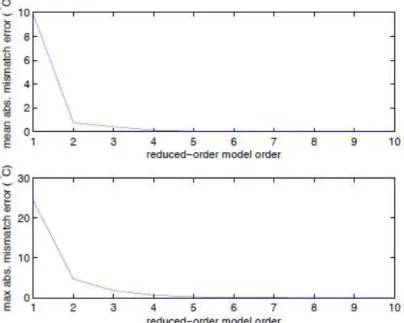
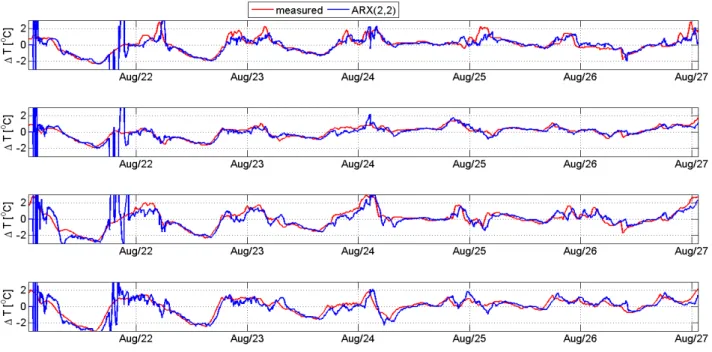
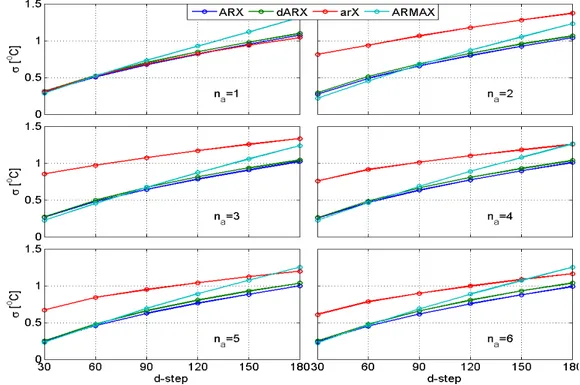
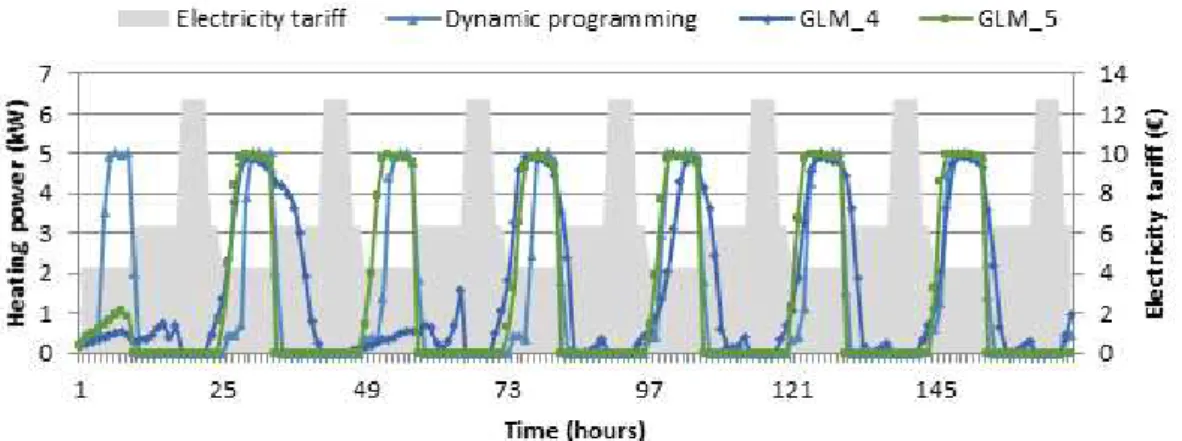
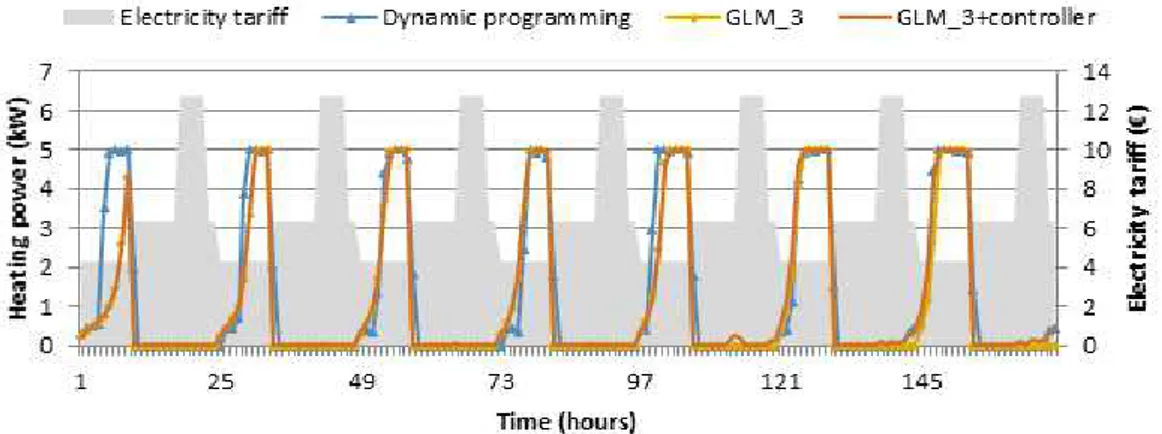
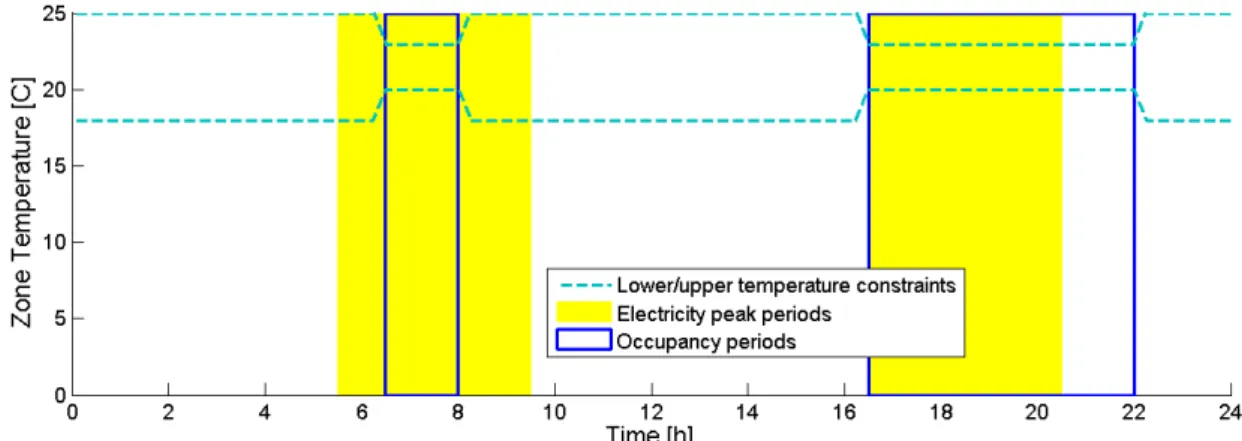
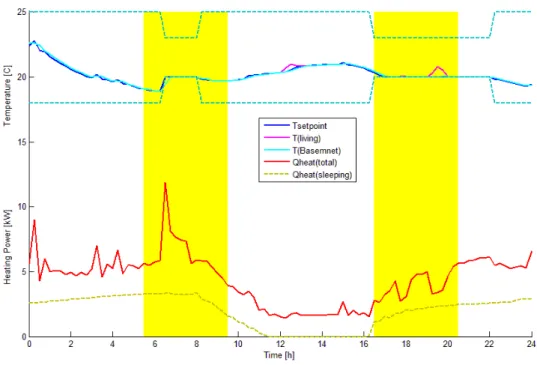
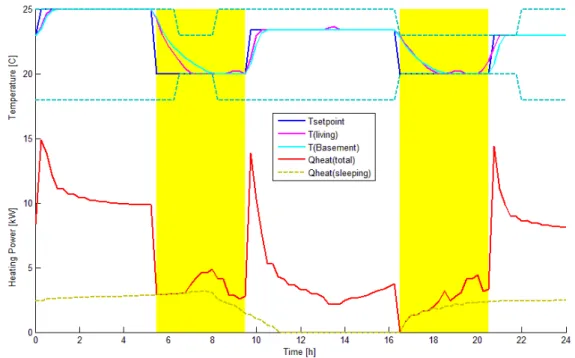
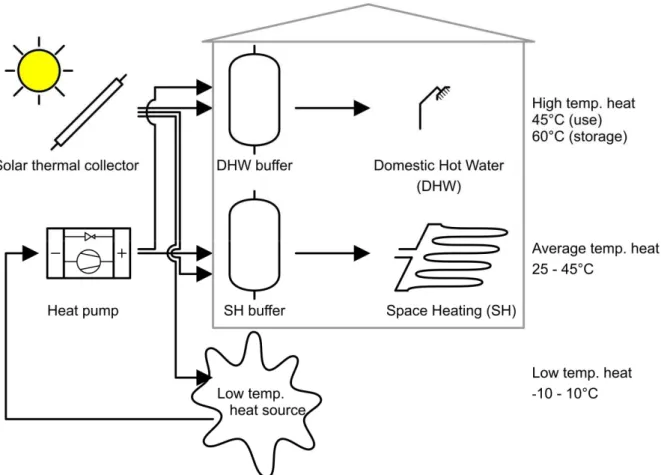
![Figure 2: Overview of existing SHP system configurations; numbering according to original publication [Henning et al.; 2008]](https://thumb-eu.123doks.com/thumbv2/123doknet/6690912.183700/90.892.115.780.122.590/overview-existing-configurations-numbering-according-original-publication-henning.webp)